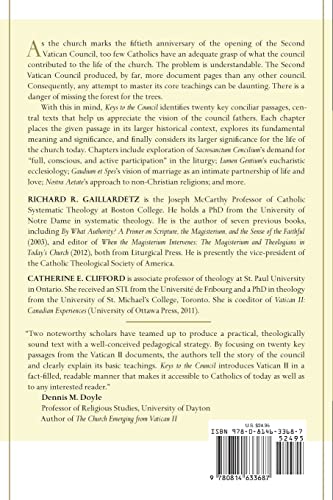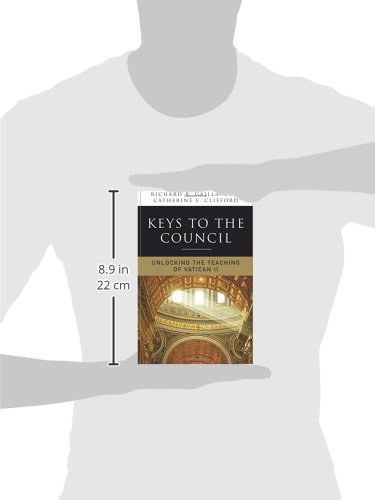معلومات عنا
حقوق الطبع والنشر © 2024 Desertcart Holdings Limited
Desert Online General Trading LLC
Dubai, United Arab Emirates




Keys to the Council: Unlocking the Teaching of Vatican II
T**S
For This New Generation That Remembers Not the Old Days
An expository summary of the theological and pastoral texts of the Council Vatican II is a more complicated venture in the 2000’s than it might have been in, say, 1970. In this century, an author may lay out the Council’s key thrusts by drawing heavily upon the texts themselves and the primary intents of the bishops as they voted in assembly. This is the approach of “Keys to the Council” [2012] and the authors have put forward the Council’s highlights in a reasonably attainable fashion for study and discussion.However, the further one gets from the close of the Council in 1965, nearly sixty years ago, an author is faced with an added challenge: the Council documents have taken on a life of their own, or more specifically, a few have bloomed, others wilted, and yet others still live in that place once consigned to unbaptized babies. In this age it is impossible to write about the decrees of the Council in their infancy without a word about how they advanced or decayed into middle age, and how their parents either overindulged them or neglected them altogether. In short, can one disclose the documents without a commentary on their reception?I believe that a working answer is yes, given that the state of adult education is such in the United States that very few adults can even recognize the documents by name [e.g., Lumen Gentium, Sacrosanctum Concilium] let alone identify the Council’s concerns regarding the Eucharistic celebration, the nature of the Church, or divine Revelation. If one is starting from ground zero—as a student or a teacher—it is best to start with a crisp and pristine summary as the one offered here.“Keys to the Council” is divided into about twenty brief chapters, each headed by a selection from a major Conciliar text. The authors’ selection is eclectic in that it leans toward matters of ecclesiology or the nature of the Church. There are six chapters on Lumen Gentium, three on Gaudium et Spes, and one on Christus Dominus [the role of bishops], totaling a significant collective commentary on the Church. Sacrosanctum Concilium [on the liturgy] has two entries, Dei Verbum [on Divine Revelation] has two, and Nostra Aetate [on non-Christian religions] has one. Richard R. Gaillardetz, one of the two contributing editors, has devoted much of his career writing to the nature of the Church, which may account in part on his ecclesial emphases.The expositions are generally lucid and comprehensive, providing, when possible, some historical feel for the “pre” and “post” Vatican II understandings of the issues at hand. For example, discussion of the nature of Christ’s presence in the Church in this work evolves from the pre-Conciliar emphasis upon the legal definition of Church structure and the Sacrament of Orders to the post-Conciliar pneumatic or Spirit-filled understanding of Christ’s presence in the Church and world today. The authors explain the use of the “Ressourcement” method by theologians, the attempt to recover the original thinking and practice of the ancient Church fathers and communities. The Ressourcement method shaped much of the thinking of the Council fathers. There are very useful inclusions of definitions of terms which may be unfamiliar to the novice adult student of theology—such as neo-Scholasticism, magisterium, dogma, infallibility, etc.Speaking from my anecdotal experience, I see present-day interest in this work coming from those who are engaging in their Synodal processes and the reform spirit of Pope Francis. The recently completed first phase of the synodal consultation has interested some grassroots among Catholics to delve more deeply into the life of the Church. Granted, less than half of one percent of U.S. Catholics actively engaged in the synod discussions, but many of those who did get involved are motivated to pursue discussion and, more importantly, the principles behind Francis’s reform of the Church. They will be looking for texts and their parochial mentors will be seeking out resources.In this context, “Keys to the Council” is a useful work. It does not overwhelm the reader/student with the immense content of the Council—close to one thousand pages of material—but provides a focus on the texts of the Council’s vision of the life of the Church, which is probably the best place to begin for a baptized Catholic on the road to an adult understanding of the Catholic life. I would say, though, that this text needs to be taught as well as read, meaning that there is plenty of conciliar material here which needs the academic/professional counsel of background and, as I noted above, something of an informed “state-of-the-union” on why the Council has not produced all the fruits of its promise.I should note here that Gaillardetz authored another Vatican II study, “An Unfinished Council” [2015] a few years after our text under review. To cite one reviewer of the 2015 work, Gaillardetz “has given us a compelling account of the work that still needs to be done.” While it may be tempting to jump ahead to such speculation, it would seem wise to begin at the source with an analysis of what the Council actually taught—and where its original implementation succeeded and failed. Consequently, I would recommend reading these books in the order they were written—and better still, in a guided reading/study format.
R**R
This seller describes his wares well!
I am well pleased with the condition of the used book; it was like new just as the seller had described.
R**G
Excellent read
This is one of the best summaries and explanations of the documents of Vatican II that has ever been printed. The authors do a superb job of explaining the history and background of each article and excerpting a quote from the appropriate document voted on by the Council Fathers. One does not need to be a theologian to understand what was voted upon and what effect the article has on the People of God. I recommend this highly for anyone interested in learning more about what occurred at Vatican II and why. There is an attempt to reform the Reform; but the Council Fathers did a great job nearly 50 years ago. We would all do well to leave it alone and allow the Holy Spirit to work without help from every reactionary from Rome to Lincole,NE.
P**S
Vat II documents explained.
The authors of the book have put together a great text that is easy to read and understand, even by the average lay person in the Church. It has given me a greater appreciation of what went on during the Council, and a better understanding of the documents. I am currently using this as a course book in a college program. I ordered book from Amazon and it arrived sooner that I expected.
K**T
Vatican 2
I was attending a series of lectures on Vatican 2 and felt very ignorant. This was the better of the 2 recommended books and I learned a lot from reading it. It is clear and interesting, not hard to read for a layperson.
C**R
Gaillardetz
This man is one of the smartest people I've ever met and his explanations of Vatican II are superb, succinct, and to the point. I have recommended this book to all those conservative folks who claim Vatican II was a big mistake and some of them have had their eyes opened by this writing.
M**E
Thorough treatment of major themes
This book provides a complete discussion of the teaching of Vatican II. It Is not light reading, however. And it might be too "dense" for those who have little background in theology or philosophy. I would not consider this an introductory treatment, especially if the reader did not live during the Vatican II years.
S**N
Brief but helpful
Gaillardetz is good at synthesizing and summarizing. This book does it well, but gives little background on the inner workings of the Council. But, that was not its purpose
J**H
Excellent book
A clear and concise account of the Vatican Council with stimulating insights and clear presentation - often saying what I already knew but in an attracitve new way.
J**S
Scholarly but also easy to read
Very valuable for both those who are new to the Council and those who have already more knowledge. The book does indeed unlock key teachings of Vatican II.
A**N
Key to the Council: Unlocking the Teaching of Vatican 11
This book is concise and well summarised, easy to read, well documented with clear explanations of the Vatican DocumentsExcellent
F**H
A Must Read
Catherine Clifford and Richard Gaillardetz have collaborated on on a well researched insightful new look at how Vatican II was meant to form the church as well as inform. Their approach is easy to read with ecclesial terms defined, a good index to the documents and suggestions for further reading.
H**N
Five Stars
An excellent revue of the important documents of the council by two experts in that field! HVL
ترست بايلوت
منذ 3 أسابيع
منذ أسبوعين